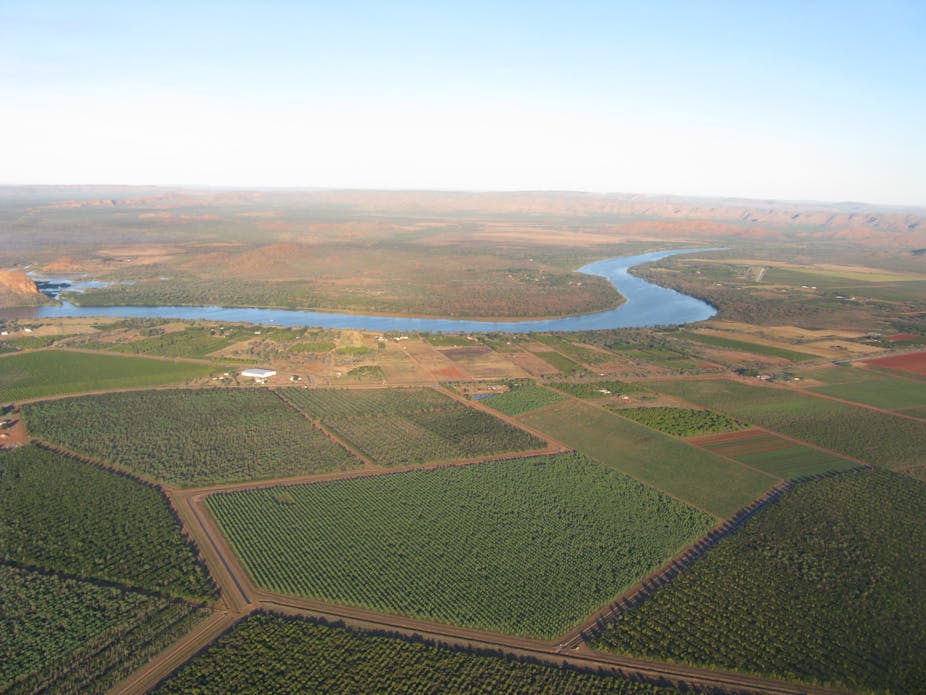Northern Australia has vast potential for development. Just one proposed agriculture project of the many that I’m currently aware of would cover an area as big as metropolitan Brisbane, Australia’s third largest city.
Other single farms could be as large or larger than the entire Ord River scheme in Western Australia, home to mainland Australia’s biggest freshwater dam at Lake Argyle, which can store roughly 20 times the water in Sydney Harbour.
Those are just some of the major projects on the drawing board for northern Australia, which have attracted the interest not only of Australian investors, but also investors from the US and China. Such foreign investment will be crucial to what happens over the next few decades in places such as the Flinders and Gilbert river catchments in north Queensland.
But with vast potential also comes vast, and as yet not entirely well-understood, challenges. For instance, how do we fund the infrastructure to capture, store and distribute the water from the wet season to support agriculture all year round? And where are the most appropriate places to build proposed new water storages?
Those are some of the questions being asked again, with the federal government this week asking for public comment on its new Green Paper on Developing Northern Australia. The paper is a precursor to a new national policy for our north.

Released this week by Deputy Prime Minister Warren Truss, the green paper is a good start in the process of developing a plan for the north.
The risk to successful development in the north is in underestimating both the scale of the opportunity and the scale and complexity of the challenges. Many past attempts at development have failed on both these counts.
So there is much work still to be done before being able to predict if this new push to develop northern Australia will succeed where past plans have failed.
Economies of scale
If Australia’s new national policy for developing northern Australia is to get anywhere, one of the most important issues for it to address is the huge scale of investment required to get major new projects off the ground.
We also need to define the paths to winning a significant share of high-value Asian markets.
The green paper suggests the northern economy should be diversified into areas other than mining and energy. Tourism and agriculture — and I’ll largely focus on agriculture, as it’s my area of expertise — are the two main options identified.

Some past failures in agriculture in the north can be attributed in transplanting agricultural technology from the south, rather than re-inventing it for the new northern environment.
Globally we have had much more research and development delivering technology into temperate agriculture rather than tropical agriculture, where we now have the greatest need in Australia and globally.
Australian research and development capability in this area is strong, and should provide a competitive advantage in developing our north, one of the few remaining areas in the world with potential for agricultural expansion.
Working with local conditions
The green paper cautiously does not attempt to pick winners in backing specific industries.
Agriculture in the north may continue to depend upon the established industries such as beef for some time, but new agricultural ventures will have a wide range of options, requiring careful evaluation. Agricultural and food products that can thrive in northern Australian conditions need to be identified.
The scale of investment is a big challenge. For example, establishing new farms in remote northern locations could require new roads and rail to get the products to a port or market.
As the Deputy Prime Minister noted this week, water storage and distribution systems may need to be constructed. But new dams aren’t cheap, meaning large-scale investments would be needed.

Single farms as big as the entire Ord River scheme or possibly even larger are now being considered. That has major implications for the policies that need to be developed by government to attract large-scale investment.
Businesses of this type might resort to a fly-in, fly-out workforce, following the mining industry’s example. But the social implications of fly-in, fly out farming need to be better understood.
Investing in success
Development of the north will require that governments at all levels create an investment environment that will attract the significant capital essential for new ventures in the north. That means getting the balance right between removing red tape and ensuring investment in sustainable industries.
A key to success for Australian agriculture will be in successfully targeting high-value niche markets for food products in Asia.
These Asian markets are large and — despite the niche label — are able to take all that Australia can produce of most foods, as I’ve written about for The Conversation before. Niche markets tend to pay higher prices, but they may also be highly competitive and require sophisticated marketing and quality control.
But rather than just producing food and then exporting it for others to process further, on-farm processing in northern Australia is likely to be essential to many businesses.
We’re not talking about small, family-run farms, but big businesses, covering bigger areas and able to capture greater economies of scale.
Alongside business, Australian scientists will have a key role in delivering the appropriate new crops, new animals and new farming systems that will be necessary for agriculture to succeed in the north.
Developing more remote areas of northern Australia comes with bigger challenges than setting up new ventures in established areas like the Murray-Darling region.
But the opportunities are there. Now we need to ensure that government policy settings and business plans are well-targeted, so that developing northern Australia finally moves on from being a long-held dream to becoming a reality.

